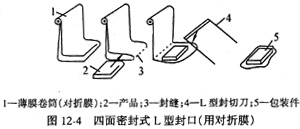If wrapping with a tubular film, it is only necessary to perform simultaneous sealing, piercing, and thermal shrinkage when the tubular film is cut. As shown in Figure 12-2, cut off at the same time as C.
If the folded film can be used L-type sealing method. In this method, the film is folded on a roll, the film is pulled out to a certain length in a horizontal position, and the open end is stretched by a mechanism or by hand, and the product is pushed to the crease. Before this, the last heat-sealed cut is left. The next transverse joint, plus a total of two seams, does not need to be sealed. Then use an "L" type cutter to press down from the back of the product and the film joints and heat-seal the shear seams to complete one longitudinal joint at a time. Easy to operate, manual or semi-automatic. Suitable for packaging shaped and dimensional change products. The operation process is shown in Figure 12-4.


(3) Open-end wraps at one end: Open-end shrink wraps, which accumulate on pallets for transport packaging. Most of its processing methods use shrink packaging film (tubular film or flat film), which is pre-formed into a shrink-wrapping packaging bag by a bag-making device. (The shrink-wrapped bag is about 15% to 20 times larger than the size of the tray and stack to be packaged. %). When wrapping, the bag is first stretched out, and then the tray and the accumulation are nested. When there is no special sealing requirement, the lower end is not closed, and then the tray is heat-shrunk. As shown in Figure 12-6.

2. Heat Shrinking Operation In a heat shrinkable package, the packaged article is wrapped with heat shrinkable film material as required and then transported to a heat shrink device. Heat shrinking devices are called heat shrink tunnels (also called heat shrink tunnels) and consist of conveyors, heaters, and cooling devices. The heat shrinking process is: the prepackages are placed on a conveyor belt, the conveyor belt runs at a specified speed, is sent to a heating chamber, is heated by blowing hot air to the package, and the heat shrinks off the heating chamber, and after natural cooling, the conveyor belt is cooled. Remove it. When the bulk heat shrinkage temperature is high, the cooling fan is often accelerated after leaving the heating chamber.
At present, the commonly used conveyors in shrink tunnels are heat-resistant belts, automatic rollers, rollers, platens, plate chains, and other types. Their surfaces should not stick to the shrink film, and the heat carried by the conveyor should be minimized. The delivery device for the shrink tunnel is related to the film; the weight of the items that can be driven by the structure is different. For example, heat-resistant belts, suitable for polyethylene, vinyl chloride film, can not carry heavy items; plate chain with a suitable film only polyethylene, can load objects for tray shrink packaging.
The heating chamber is a box-shaped device with insulation material inside. Among them are heating ventilation devices and temperature control devices. There are usually two doors, one in and one out, the wind blown by the thermal circulation fan is heated by the heater into hot air, and blown through the air outlet to the pre-package. The heating method of the heater can use far infrared rays of electric appliances, fuel, and gas. To properly configure the air outlet, and reasonably select the scenery and wind speed, so that all parts of the package can substantially complete contraction at the same time. The heat shrinkage process ensures uniform shrinkage and the hot air is forced to circulate. The temperature of the heating chamber is controlled by a temperature automatic adjustment device so that the temperature difference of hot air is not more than ±5°C. The heat shrinkage channel is shown in Figure 12-7.

Table 12-1 Â The main parameters of commonly used shrink film and heat collection channel
0.12 to 0.20160 to 200
180~2008~10
30~606~10
12 ~ 16 long contraction time necessary to stop heating
Third, heat shrink packaging equipment At present, there are many types of foreign shrink packaging machines, such as groceries, food, industrial parts and other packaging NS type L-2 semi-automatic shrink packaging machine; applicable to food containers magazines and other packaging NS type A-8 automatic shrink packaging machine; NS type A-1C automatic shrink packaging machine, etc. suitable for plywood, metal plate and other flat product packaging. There are dozens of kinds. Some packaging machines are also widely used in China. The following briefly describes several domestic common shrink packaging machines.
1. Small shrink packaging machine is mainly used for packaging fruits and fresh vegetables, generally packed in pulp or plastic platters, such as apples, oranges, tomatoes, etc., but also without shallow dishes, such as cucumbers, carrots, bananas and so on. Due to the small package size, pillow-shaped bag-type packaging is used mostly, and its structure is similar to a horizontal pillow-shaped bag packaging machine. The temperature of the corresponding heat-shrinkable channels differs depending on the packaging material. When using a polyvinyl chloride film, it requires 90 to 180°C; when using a polyethylene film, it requires 160 to 240°C.
2. L-type sealing type packaging machines generally use reel type folding film and feed manually. The packaging capacity depends on the size of the package and the proficiency of the operator. Usually about 10 to 15 packs/min.
3. Plate type heat sealing packaging machine is used for open end and four-side sealed packaging, such as packaging multiple cartons or bottles, canned products. Packaging capacity depends on package size, product weight, and film thickness. Usually 15 to 25 bags/min.
4. Large shrink packers are used to pack corrugated cartons and bulk bags. The length, breadth and height of the package are generally more than 1m. There are trays and trays.
Pressed Tumblers,Glass Mug Co., Ltd. , http://www.pressedtumblers.com